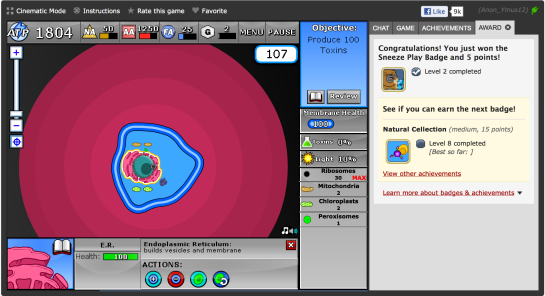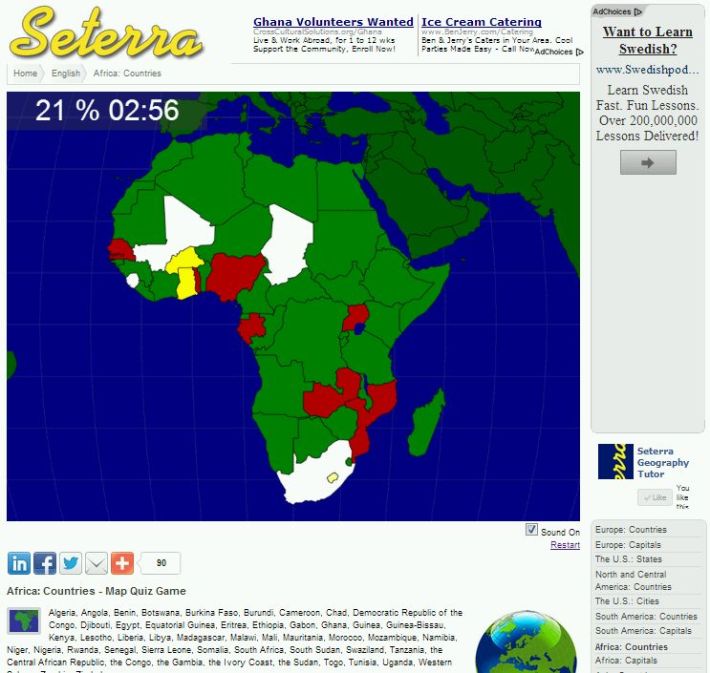CellCraft is a free cell biology game available online (full screen swf) or for download/offline. The game covers the very basics of cell function and organelles, at about the level I learned in middle school. Terms that were well covered include nucleus, ribosomes, RNA, ER (Endoplasmic Reticulum), peroxisome, lysosome, Golgi body, vesicle, fatty acid, amino acid, glucose, nucleic acid, as well as others that are less central to game play. If you’d like to see the whole list, select the full screen link above and flip through the encyclopedia – or better yet, play the game. I think that taking it slow the game could take 2-3 hours depending on the player, I managed to blitz though in about 45 minutes, but that didn’t leave as much time for learning.
What I love about this game is that it really is a game. There are characters, a story, jokes, and a serious chance to fail – even if failing just means restarting the level. Which means that kids learn without ‘studying’ because the game play depends on understanding that ATP is fuel, and lysosomes dissolve things, etcetera. To top it all off, the game is pretty. It’s not cutting edge, but it looks slick and runs well (some hosting sites glitch out about 2 minutes into the game, but I have not had that problem with the links above).
Ease: 10/10
Aesthetics: 10/10
Entertainment: 10/10
This game was designed with middle school students 11-13 year old in mind, and to be potentially useful for high school students aged 14-18.1 It would probably not be very useful in a college environment, but I cannot imagine a more useful tool for starting off a middle/high school into to biology course unit on the cell.
It is important to understand that this is a game, and like all games it involves fantasy. Fantasy in games can come in two forms – exogenous fantasy or endogenous fantasy.2 An exogenous fantasy has nothing to do with material and could be used to teach almost anything. Example of an exogenous fantasy include hangman, the classic game concentration/memory, the games scatter and space race at Quizlet, or anything found here. The problem with exogenous fantasy is that it is less compelling than an endogenous fantasy, and is less effective at getting the user to really engage in the material.
In contrast, endogenous fantasy is woven into the game itself – meaning that not everything that is said is literally true, because there is a fictional story driving the actions of the player. CellCraft is such a game. For instance, there is no reason to believe that the platypus originated on another planet, or anything else in the plot of this game. Also, you cannot just drop organelles into cells, and everything in the game is simplified to make the mechanics of the game work. BUT if you want kids to remember things like ATP is cellular fuel, and that it comes from glucose, and that glucose is more efficiently turned to ATP by mitochondria, this is a great game. A follow up lesson will probably be necessary to clear up questions about what is and isn’t realistic about the game – but that should not be a problem.
I would recommend it as a homework assignment, with an alternative worksheet for those who can’t or wont play, and including the encyclopedia as required reading. Then, have the students write out questions about the game, and take a quiz to make sure they actually played it. There will be some explining to do, but anything that gets kids to ask questions is a good thing, at least in my book.

Level 8, with a lot of the organelles installed and functioning. Played on Kongregate (the online link) which allows saving progress but that requires registering account.
Released July 2010
1See AnthonyP’s comment.
2 Loyd P., R. (1996). Seriously considering play: Designing interactive learning environments based on the blending of microworlds, simulations, and games. Designing interactive learning environments based on the blending of microworlds, simulations, and games, 44(2), 43-58. Retrieved from http://link.springer.com/article/10.1007/BF02300540 – See the section on games.






